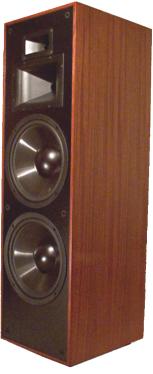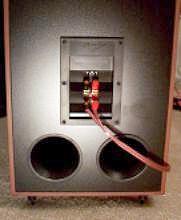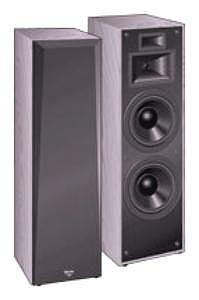Product Review - Klipsch KLF-30
Legend Tower Floorstanding Speakers - March, 2000
Brian Weatherhead
![]()
|
Klipsch KLF-30 Legend Tower Floorstanding Speakers Bass Reflex, Two Rear-Firing Ports MFR: 36 Hz - 20 kHz � 3 dB Sensitivity: 102 dB/w/m Impedance: 8 Ohms Nominal Power Handling: 200 Watts RMS, 800 Watts Peak Size: 46 1/2" H x 14" W x 17 1/4" D Weight: 92 Pounds Each MSRP: $1,800/Pair; Mahogany, Oak
|
| Klipsch, Web http://www.klipsch.com/ |
Introduction
I first listened to the Klipsch Legend Towers at my local Ultimate Electronics. I was out looking for a new home theater system, but I also wanted the equipment to serve as an audio system too. I listened to the Legends, comparing them with speaker sets from Definitive Technology, Polk Audio, and M&K. In the Legend line from Klipsch, there are three sizes to choose from:
KLF-10
(Two-way Tower)
One 1� compression driver loaded horn
Two 10� Woofers
KLF-20 (Three-way Tower)
One 1� compression driver loaded horn
One 1.5� compression driver loaded horn
Two 10� Woofers
KLF-30 (Three-way
Tower)
One 1� compression driver loaded horn
One 1.5� compression driver loaded horn
Two 12� Woofers
The KLF-30 series is the largest and by far the
best of the three in
the series. After a long listen at the store, I chose the Klipsch, the details
of why I made this choice to follow below. The local dealer didn't have a pair for sale, so I
went to Klipsch's web site and found a dealer. After a quick call to New
York, I learned that these speakers are VERY heavy, and that shipping would
take a while.
So I waited
. . . .
The Specs
Klipsch is very well known, if not notorious, for their horn speakers.
The KLF-30 has a very high sensitivity (102 db). Therefore, they do not require
a large amount of power to play loud, but they can handle a large amount of
clean power.
The KLF-30s have a two-horn design with a 90�x40� tweeter horn, and a 90�x60�
mid horn. They also include two 12� bass drivers, that are as tight as can
be (in other words, they don't have a "floppy" bass sound).
Arrival
The day that they arrived, I learned first hand how heavy these towers
are. It took two people to unpack them and move them around the room. Klipsch
lists the speaker at 92 pounds, but my back insists that they are closer to
150. I purchased the mahogany finish, and it's simply stunning. The
finish after all is very important, as these towers are about 4 feet tall, and
little over a foot wide. So, there is no hiding them behind the couch. I connected the
KLF-30s to my Pioneer Elite receiver and put in a Bach CD. Then, I let the
speakers play for an hour at low volume, followed by three hours at medium
volume. After that, I played a few of my classical and
pop CDs, adjusting the imaging by changing their position. I used the Video Essentials CD
for adjusting the imaging and a tape measure to set the time delays in the
receiver.
I
spent the next week playing various material, not wanting to be critical until
I felt that the speakers had �broken in.� This �break-in� point became
obvious during the third week, as this was when I felt that I needed to
re-adjust the imaging and levels of each speaker. After this final calibration,
I performed my critical evaluation.
Evaluation
When I evaluate speakers, I listen specifically for a few criteria which I feel are the most important. These are general areas, and to different people these criteria are less important that others
-
Impact and Level response
-
Sound Stage
-
Frequency Response (Room Response)
-
Quality of Materials and Construction
-
Price (Value)
Impact and Level Response
The KLF-30s
have two 12� drivers, and they play loud (to say the least). Listening to
pop songs with kick drum and punchy bass lines was a new experience. As the
level increased on my receiver, so did the impact of sound. Never did the music
sound strained or choppy. Also to note, I tested the horns out listening to
the �Titanic Soundtrack� at 115 dB. The flute sounded smooth, and the sound
was very directional. Never did the flute sound harsh. I expected the horns to
feel harsh at higher volumes, and there were times where I felt it was painful
to listen, but a glance at the SPL meter read at 123 dB, so I should expect it
to be a little uncomfortable (chuckle). Loud and clear is an understatement
for these speakers. They resemble the massive speaker systems at concerts;
they also share the same concert impact and feel. I hit over 125 dB while
listening to �La Grange� on the Armageddon sound track. Needless to say, I
felt intoxicated by the clean sound. Overall with the SPL meter in hand, the
two speakers were very matched, and there was only 1 dB difference in the play level
between the speakers.
Sound Stage
The localization provided by horn speakers is second to none. Perceived stereo separation was very good. The horns also provide generous coverage for those listeners who are not sitting in the sweet spot. With the KLF-30s, I felt that the sweet spot was larger than with other speakers that I had listened to in the past. The dispersion of the horns was perfect. I had the speakers toed in about 10� towards the sweet spot. This gave very good directionality but also having good dispersal throughout the rest of the room. Another advantage to these speakers is that the horns are at about eye level when sitting down, which makes the sound height very accurate.
Frequency
Response (Room Response)
The KLF-30 speakers feel very smooth, never harsh sounding. They do not have a warm glow, but feel accurate. Even though these towers have two 12� speakers, they are not efficient at reproducing bass notes below 50 Hz. As you can see from the graph, they start rolling off below 150 Hz. Of course, this is a room response, not an anechoic one, so my measurements are just for interest's sake. The measurements were taken with SpectraLab Pro, on a Pentium 500 Laptop, with a calibrated Microphone.
However, those 12� drivers do produce a lot of punch at 70 Hz, where most kick drums seem to reside. As a home theater speaker, they could use the benefit of a nice powered sub. I currently use the Klipsch KSW-15, and it blends in great with the towers. I have the sub crossed at 50 Hz, which creates a very smooth transition. (Obviously, the sub was turned off during the response test.)
Quality and
Materials of Construction
The over all quality of the speakers is superb, and the two very large flared ports on the back of the towers are hard not to notice. The towers can be bi-amped, with the top connections being for the high frequency drivers and the bottom pair for the 12� drivers. The gold plated connectors are installed from the factory for single amp load. The KLF-30s are provided with optional steel feet, for isolation from the floor. I use these so the carpeting doesn't affect the towers. The wood grain and construction quality are top notch. My only complaint might be that you can see black paint or sealant splattered around the unpainted interior through the massive ports, if you like to crawl around on the floor and look into the holes.
Price (Value)
I paid
$1,199
for the pair, and they have to be the best buy that I have ever seen. The
Klipsch Legend series are truly remarkable speakers. They stand out, they have
class, and they have quality. If you are in the market for medium to higher end speaker
system, the Legend would fit the bill, especially if you have a low to medium
powered amplifier (they would be excellent for use with mass market
receivers). MSRP on the pair is $1,800, and most local
retailers are charging that if not more.
- Brian Weatherhead -
![]()
� Copyright 2000 Secrets of Home Theater & High Fidelity
Return to Table of Contents for this Issue.


